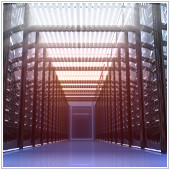 In this day and age, almost every business employs some type of server management. If yours is hosted locally, temperature control could mean the difference between running smoothly and running into the ground. Understanding how to properly cool your servers prevents data loss and ensures the longevity of your hardware’s life.
In this day and age, almost every business employs some type of server management. If yours is hosted locally, temperature control could mean the difference between running smoothly and running into the ground. Understanding how to properly cool your servers prevents data loss and ensures the longevity of your hardware’s life.
How does temperature affect my servers?
High temperatures in server hardware can result in different types of damage. A server that completely crashes for any reason results in costly data loss and service interruptions, but the unbiased advisory organization Uptime Institute warns that overheating that doesn’t always result in total failure. Every 18 degrees higher than 70 degrees Fahrenheit, hardware reliability decreases by 50%. This decrease in reliability can be just as, if not more, expensive for your hardware budget in the long run.
Cooling methods can’t just be implemented and forgotten; they must be closely monitored to ensure the health of your server hardware in the short and long term. Options for temperature management range from simple low-budget solutions to expensive outsourced alternatives. Determining your server management budget will greatly depend on what types of methods you intend to implement at your SMB.
Cooling methods
Which system you use to cool your server largely depends on how much power your hardware is using. The more watts a computer needs to operate, the harder it’s working. This number will determine the scope of your temperature management needs.
For example, PCWorld says passive temperature control is adequate for any equipment operating at less than 400 watts. This includes simple solutions like positioning your server away from walls, low ceilings, cable clusters, and anything else that can block hot air from dissipating naturally.
For computers using between 400 and 2,000 watts, strategic ventilation becomes a necessity. Adding passive ventilation is viable up to 700 watts, but fan-assisted ventilation will be required above that and up to 2,000 watts. With the increased power consumption, temperatures will rise, and air movement needs to be more closely managed. At this stage, simple vent and oscillating fans will suffice.
Anything higher than 2,000 watts needs dedicated cooling solutions. This means air-cooled units to actively reduce server room temperature. Depending on the size and arrangement of the space, a simple self-contained unit may be enough to reduce temperatures to acceptable ranges. But if you’re not sure, you should schedule a consultation with a vendor to consider more drastic cooling and monitoring methods.
Keeping your servers running at ideal temperatures means smoother data operations, lower hardware budgets, and one less thing to worry about at your SMB. As your business continues to grow and develop, keep close tabs on increasing server loads — it could save you from devastating data loss. If you need more detailed advice about server management, or have any other questions about your hardware setup, contact us today.